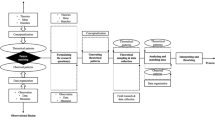Abstract
The topic of fuzzy set theory was examined using the occurrence of phrases in bibliographic records. Records containing the word fuzzy, were downloaded from over 100 databases, and from these records, phrases were extracted surrounding the word fuzzy. A methodology was developed to trim this list of phrases to a list of high frequency phrases relevant to fuzzy set theory. This list of phrases was in turn used to extract records from the original downloaded set, which were (algorithmically) relevant to fuzzy set theory. This set of records was then analysed to show the development of the topic of fuzzy set theory, the distribution of the fuzzy phrases over time and the frequency distribution of the fuzzy phrases. In addition, the field of the bibliographic record in which the phrase occurred was examined, as well as the first appearance of a particular fuzzy phrase.
Similar content being viewed by others
References
Dialog (2001a), DIALINDEX. [http://library.dialog.com/pocketguide/pktgde.pdf]. pp. 46-48, 27th July, 2001.
Dialog (2001b), Duplicate Detection. [http://library.dialog.com/pocketguide/pktgde.pdf], p. 30, 27th July, 2001.
Dialog (2001c), OneSearch. [http://library.dialog.com/pocketguide/pktgde.pdf], pp. 27-30, 27th July, 2001.
Dialog (2001d), RANK Command. [http://library.dialog.com/pocketguide/pktgde.pdf], pp. 17-21, 27th July, 2001.
Egghe, L. (1998), On the law of Zipf-Mandelbrot for Multi-Word phrases. Journal of the American Society for Information Science 50: 233-241.
Egghe, L., R. Rousseau (1990), Introduction to informetrics: Quantitative methods in library, documentation and information science. Amsterdam, The Netherlands: Elsevier Science Publishers.
Hood, W. W. (1998), An informetric study of the distribution of bibliographic records in online databases: a case study using the literature of Fuzzy Set Theory (1965-1993). Sydney, Australia: Ph.D. dissertation, The University of New South Wales. (Available http://www.library.unsw.edu.au/~thesis/adt-NUN/public/adt-NUN1999.0033)
Hood, W.W., C.S. Wilson (1999), The distribution of bibliographic records in databases using different counting methods for duplicate records. Scientometrics 46: 473-486.
Hood, W.W., C.S. Wilson (2002), The scatter of documents over databases in different subject domains: How many databases are needed? Journal of the American Society for Information Science and Technology. In press.
Lancaster, F.W., J.-L. Lee (1985), Bibliometric techniques applied to issues management: a case study. Journal of the American Society for Information Science 36: 389-397.
Saracevic, T. (1996), Relevance reconsidered '96. In: Ingwersen, P. and Pors, N. O. (Eds), Conceptions of Library and Information Science: Integration in Perspective: CoLIS 2, (pp. 201-218), Copenhagen: Royal School of Librarianship.
Tenopir, C. (1982), Distributions of citations in databases in a multidisciplinary field. Online Review, 6: 399-419.
Zadeh, L.A. (1965), Fuzzy sets. Information and Control 8: 338-353.
Author information
Authors and Affiliations
Corresponding author
Rights and permissions
About this article
Cite this article
Hood, W.W., Wilson, C.S. Analysis of the fuzzy set literature using phrases. Scientometrics 54, 103–118 (2002). https://doi.org/10.1023/A:1015688605943
Issue Date:
DOI: https://doi.org/10.1023/A:1015688605943




